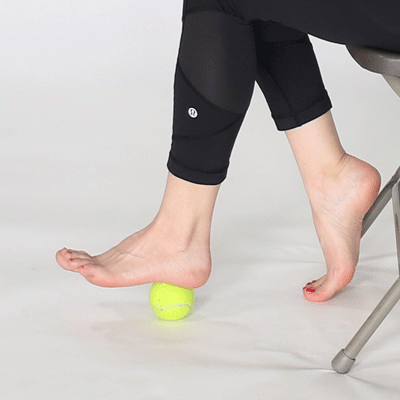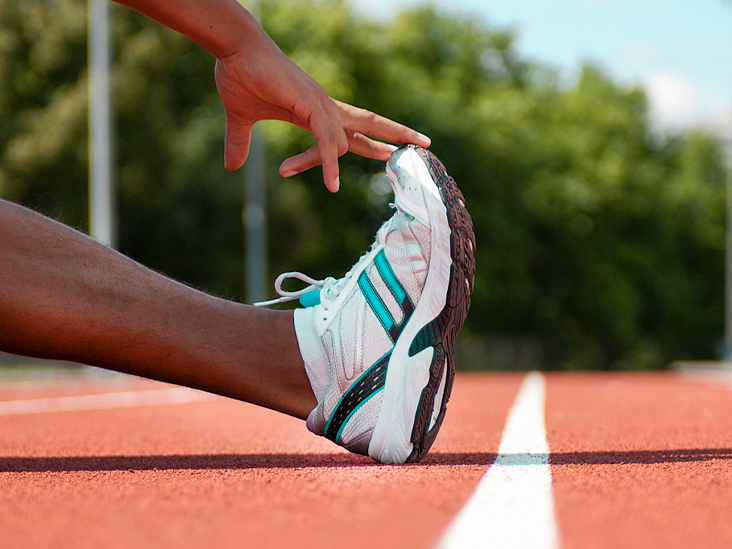Foot stretches and exercises may benefit people with plantar fasciitis by relieving discomfort, strengthening muscle strength, and increasing flexibility.
A thick band of tissue connects the heel to the toes and is known as the plantar fascia. This tissue can become inflamed as a result of overuse, strain, or injury, which can be painful. Plantar fasciitis is the medical term for this condition.
Plantar fasciitis is a type of heel pain that is deep and stabbing. It is more common in people who are overweight, although it can also happen as a result of overuse in runners. The soreness is frequently the worse in the mornings or after long periods of standing.
Tension in the foot and calf can be relieved with a few simple stretches. They can provide both immediate pain relief and a sustained improvement in symptoms over time by doing so.
Continue reading to find out which stretches and exercises can help with plantar fasciitis pain, as well as how to do them.
Rolling stretch

The foot muscles can be loosen by placing a circular object under the foot and rolling it back and forth. This exercise can be done with a rolling pin, golf ball, or specialty foam roller. Foam foot rollers are available from a variety of sports stores and internet sellers.
Another alternative for arch rolls is to use a frozen bottle of water. The chilly surface of the bottle may help relieve inflammation, making this practice particularly effective.
Stretch your foot with this simple exercise:
- Sit tall on a chair.
- Place a ball or another rollable object under the foot.
- Roll the object back and forward for 2 minutes.
Calf stretch

Muscle tightness in the feet and calves can make plantar fasciitis worse. The pain can be relieved by loosening the calf muscles. People can try a calf stretch, which consists of the following steps:
- Lean the hands against a wall.
- Straighten the knee of the affected leg and bend the other knee in front.
- Keep both feet flat on the ground.
- Hold the stretch for 10 seconds.
- Repeat the stretch 2–3 times.
Seated foot stretch

A sitting foot stretch may also be used to reduce muscle tension in the plantar fascia. These are the actions they should take to complete this exercise:
- Sit on a chair and cross the injured heel over the opposite leg.
- Pull the toes toward the shin to create tension in the arch of the foot.
- Place the other hand on the bottom of the foot to feel for tension in the plantar fascia.
- Hold for 10 seconds.
- Repeat 2–3 times.
Towel curls

Stretch the foot and calf muscles by curling a hand towel or washcloth around your toes. Before going on a walk or doing any other morning duties, people may find it advantageous to practice these stretches. The following are the steps in the exercise:
- Sit on a chair with both feet flat and a small towel in front of the feet.
- Grasp the center of the towel with the toes.
- Curl the towel toward the heels.
- Relax the foot and repeat 5 times.
Marble pickups

The foot muscles are flexed and stretched when picking up a marble with the toes. The following are some ideas to consider:
- Sit on a chair with the knees bent and the feet flat on the floor.
- Place a handful of marbles on the floor.
- Pick up one marble at a time by curling the toes.
- Repeat 20 times.
Other home treatments
Plantar fasciitis can be treated with a variety of home remedies to reduce inflammation and pain:
The RICE method
It’s important to rest the injured foot when the discomfort first develops. The RICE approach is commonly used as first aid for a foot injury:
- R: Rest the painful area for a few days.
- I: Ice the area for 20 minutes at a time to relieve inflammation.
- C: Compress the area with a soft wrap to reduce swelling.
- E: Elevate the area by putting the foot on a few pillows.
Anti-inflammatory medication
Ibuprofen and other nonsteroidal anti-inflammatory medicines (NSAIDs) decrease both pain and inflammation. It is important to follow the directions on the container or the advise of a doctor when using this medication.
Some people find that using an NSAID for a few weeks helps them feel better.
Shoe inserts
Shoe inserts give additional support for the arch of the foot. Plantar fascia inserts reduce stress on the fascia and may be especially beneficial for people who spend a lot of time on their feet. Arch inserts that are soft and supportive can also be used.
For more information, people interested in this option can speak with a podiatrist, a doctor who specializes in foot health.
Ice massage
Some people find that rubbing the wounded foot with ice helps them feel better. Focusing on massaging the arch of the foot around the painful area is the best method.
Medical treatments
If stretches, exercises, and other at-home therapies are ineffective, a doctor or podiatrist may suggest medicinal treatment.
They might recommend the following:
- physical therapy
- cortisone injections
- extracorporeal shockwave therapy (EST)
Surgery is rarely required, but it is a viable alternative if other therapies fail.
Risk factors
Plantar fasciitis is a fairly frequent condition that affects 7–10% of the population. Doctors are baffled as to why some people suffer from this injury while others do not.
However, there are a number of identified risk factors for plantar fasciitis, including:
- standing for long periods
- walking or running for exercise
- having tight calf muscles
- having excess body weight
- having pes cavus, a condition that causes increased arch height
Outlook
Without medical therapy, plantar fasciitis normally goes away in 6–18 months.
Plantar fasciitis, on the other hand, can develop a persistent problem in some people. Symptoms may ease before reappearing, or the discomfort may persist for a year or longer. According to a 2018 study, people who have had the disease before are more likely to get it again.
Conclusion
Plantar fasciitis is a frequent overuse condition among runners and people who are overweight. It happens when the plantar fascia, a thick band of tissue that runs along the bottom of the foot, becomes inflamed and uncomfortable.
Plantar fasciitis is commonly treated at home with stretches, rest, ice, and nonsteroidal anti-inflammatory people (NSAIDs). It’s best to see a doctor if the symptoms don’t go away.
Sources
- https://bestpractice.bmj.com/topics/en-us/487
- https://orthoinfo.aaos.org/globalassets/pdfs/2017-rehab_foot-and-ankle.pdf
- https://www.ncbi.nlm.nih.gov/pmc/articles/PMC5844527/
- https://www.medicalnewstoday.com/articles/324353
- https://www.ncbi.nlm.nih.gov/pmc/articles/PMC4853481/
- https://www.ncbi.nlm.nih.gov/pmc/articles/PMC5403108/






